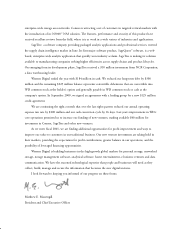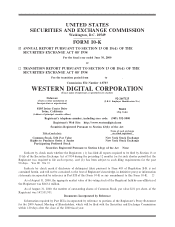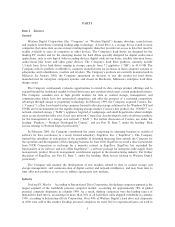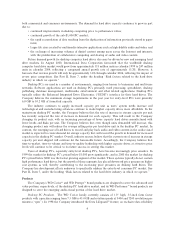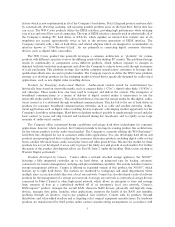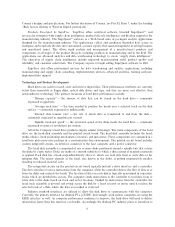Western Digital 2000 Annual Report Download - page 15
Download and view the complete annual report
Please find page 15 of the 2000 Western Digital annual report below. You can navigate through the pages in the report by either clicking on the pages listed below, or by using the keyword search tool below to find specific information within the annual report.magnetoresistive head technology and certain manufacturing and performance issues encountered as the
Company extended thin Ñlm head technology to its limits. The Company completed its transition to
magnetoresistive technology in 1999 and completed its transition to giant magnetoresistive technology in 2000.
During the Ñrst quarter of 2000, the Company lost market share as a result of a previously announced product
recall; however, the Company recovered some of its market share as it regained a leadership position in quality
and time-to-market during the remainder of 2000.
The desktop hard drive market is characterized by more competitors and shorter product life cycles than
the enterprise hard drive market; therefore, it has traditionally been subject to periods of sustained and severe
price competition, and factors such as time-to-market can have a more pronounced eÅect on the success of
any particular product.
In the network attached storage market, Connex competes primarily with established server companies
like Compaq and Dell and with network attached storage makers Hewlett Packard and ProComm. The
Company expects that the products under development by Connex will face signiÑcant competition from
established manufacturers of servers and of network attached storage devices. For an additional discussion of
the challenges facing Connex, see Part II, Item 7, under the heading ""Risk factors related to Western Digital
particularly.''
Advances in magnetic, optical or other data storage technologies could result in competitive products that
have better performance or lower cost per unit of capacity than the Company's hard drive products. High-
speed semiconductor memory could compete with the Company's hard drive products in the future.
Semiconductor memory is much faster than magnetic disk drives, but currently is volatile (i.e., subject to loss
of data in the event of power failure) and much more costly. Flash memory, a nonvolatile semiconductor
memory, is currently much more costly and, while it has higher ""read'' performance than hard drives, it has
lower ""write'' performance. Flash memory could become competitive in the near future for applications
requiring less storage capacity than hard drives can provide.
For an additional discussion of competition, see Part II, Item 7, under the heading ""Risk factors related
to the hard drive industry in which we operate.''
Service and Warranty
Western Digital generally warrants its newly manufactured hard drives against defects in materials and
workmanship for a period of one to three years from the date of sale. The Company's warranty obligation is
generally limited to repair or replacement of the hard drive. The Company has contracted with a third party in
the United States to process and test returned hard drives for the Company's end users. The Company
refurbishes or repairs its products at a third-party service facility located in Singapore and at a third-party
service facility located in Germany.
Manufacturing
To be competitive, Western Digital must manufacture high quality hard drives with industry leading
time-to-volume production at competitive unit cost. The Company strives to maintain manufacturing
Öexibility, rapidly achieve high manufacturing yields and acquire high-quality components in required volumes
at competitive prices. The critical elements of Western Digital's hard drive production are high volume, low
cost assembly and testing, and establishment and maintenance of key vendor relationships in order to create
""virtual vertical integration.'' By establishing partner relationships with its strategic component suppliers, the
Company believes it is able to access ""best-of-class'' manufacturing quality without the substantial capital
investment associated with actual vertical integration. In addition, the Company believes that its virtual
vertical integration model enables it to have the business Öexibility needed to select the highest quality low
cost suppliers as product designs and technologies evolve.
Hard drive manufacturing is a complex process involving the assembly of precision components with
narrow tolerances and extensive testing to ensure reliability. The assembly process occurs in a ""clean room''
environment which demands skill in process engineering and eÇcient utilization of the ""clean room'' layout in
10


